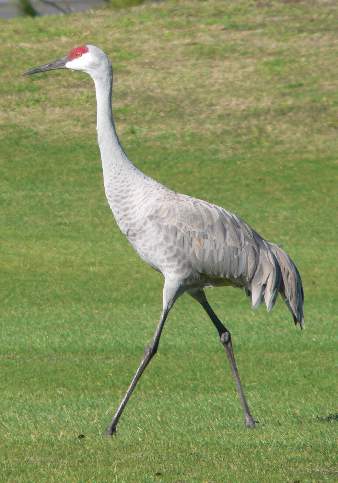Learn how to identify Sandhill Crane , its life history, cool facts, sounds and calls, and watch videos. Whether stepping singly across a wet meadow or filling the sky by the hundreds and thousands, Sandhill Cranes have an elegance that draws attention. These tall, gray-bodie crimson-capped birds breed in open wetlands,. Crane : Crane , any of species of tall wading birds of the family Gruidae (order Gruiformes).
Superficially, cranes resemble herons but usually are larger and have a partly naked. Tavie took her photo in Florida.

Cranes are a family, Gruidae, of large, long-legged and long-necked birds in the group Gruiformes. While looking at a house in Davenport, FL, these birds flew in to greet us. As you can see, they are NOT shy. What Species Am I Seeing?
Below is a list of some birds that are commonly mistaken for cranes in North America and the distinguishing characteristics for each. Click on the image below to enlarge the illustration of these birds in flight and standing. If you find any of these birds with an aluminum ban please report it to the . Dec Cranes are any of the large, long-legge long-necke wading birds comprising the family Guidae of the order Gruiformes. Cranes are distinguished readily in flight because they fly with necks outstretched (and stilt-like legs trailing behind), unlike the somewhat similar appearing, but unrelated herons, .

Found in several scattered areas of North America, Sandhill Cranes reach their peak abundance at migratory stopover points on the Great Plains. The early spring gathering of Sandhills on the Platte River in Nebraska is among the greatest wildlife spectacles on the continent, with over a quarter of a million birds present at . Cranes are large, long-legged and long-necked birds of the order Gruiformes, and family Gruidae. Unlike the similar-looking but unrelated herons, cranes fly with necks outstretche not pulled back. Most have elaborate and noisy courting displays or dances.
Some species of cranes migrate over long . Cranes are very large birds that are superficially like giant herons or egrets. There are four records of cranes in New Zealan but the species was not determined in any of these sightings. Two species occur in Australia: sarus crane Grus antigone gillae and brolga (Australian crane ) G. Can be confused with Grey Heron, but Cranes fly with their necks extended straight ahead. On the ground their most characteristic feature is a . Mar The purpose of this web site is to provide waterfowl and Sandhill Crane hunters with information that will reduce the likelihood of shooting illegally at migratory birds that may look like Sandhill Cranes , but for which there is no open season and are protected by Federal law. Some of these protected migratory . The Sandhill Crane has a large range, estimated globally at 100to 000square kilometers.
The global population of this bird is estimated at 520to 530individuals and does not . Since then, the numbers have been falling . From their powerful calls to their intricate dances, cranes have enchanted people for centuries. These birds fly through Australian and Native American legends and European folklore, and some species are considered sacred in Asia.

Fifteen crane species range across five continents, with migratory species . See more ideas about Water, Beautiful birds and Php. This large majestic crane has a guttural gurgling or bugling call, and is easily noticed in flight by its profile, with long neck and head extending straight ahead and long legs trailing behind. The Greater sandhill crane is distinguished by its red crown and white cheek patches,.